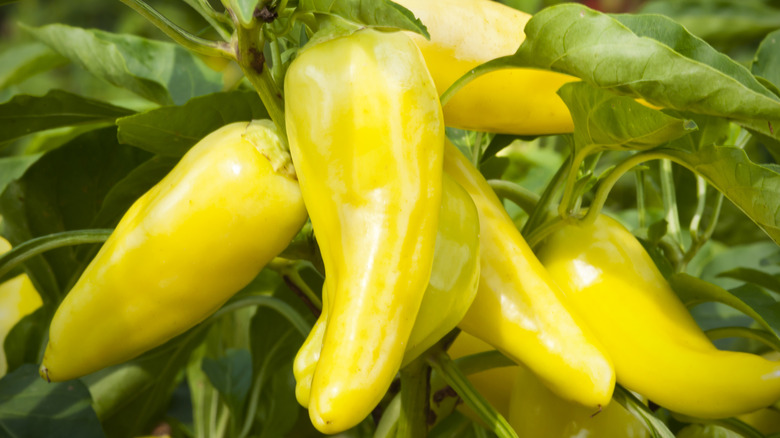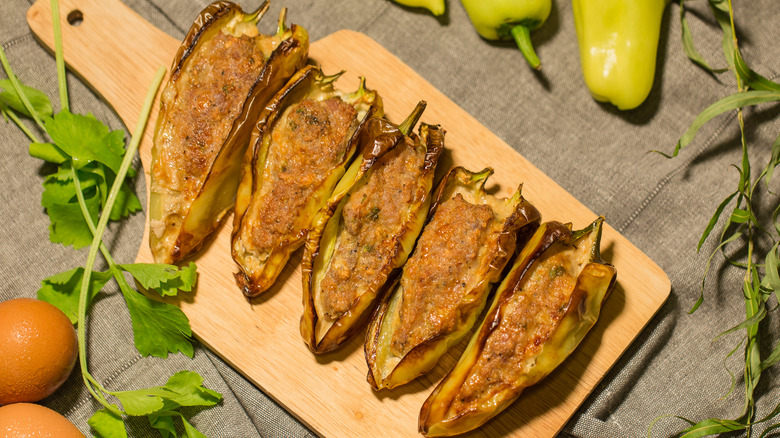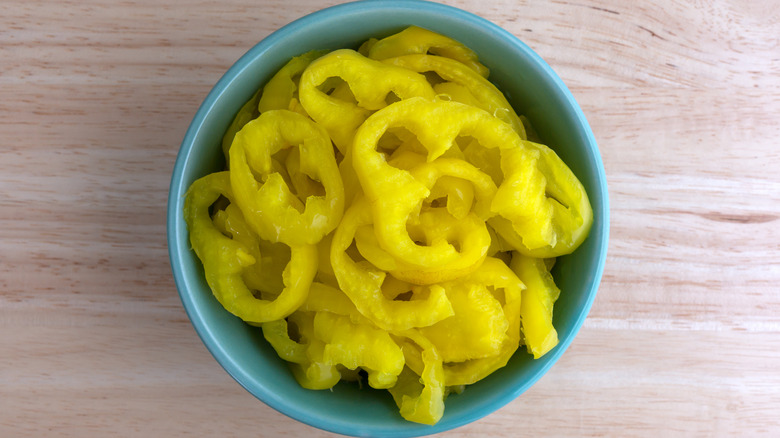How To Use Banana Peppers To Their Full Flavor Potential
Banana peppers are often overlooked in favor of sweet bell peppers for salads or pizza toppings. Because they're not as widely available as other varieties, many of us are only familiar with their pickled form, which are often confused with the spicier pepperoncini peppers. However, the end of summer is peak season for these long, pointy yellow peppers, especially if you can find them grown locally.
Available in both sweet and mildly spicy varieties, banana peppers are known for their smooth, waxy skin. You might also find them labeled as yellow wax peppers in grocery stores. Much like their popular bell pepper cousins, banana peppers can be enjoyed raw, sautéed, roasted, or grilled. They are particularly tasty when pickled, offering an extra briny kick to dishes that could use a flavor boost.
Stuffed peppers are also a staple in many cuisines, and banana peppers hold up well to baking due to their firm, waxy structure. While many recipes call for larger bell peppers, smaller banana peppers are also a great option. Unlike bell peppers, which are usually stuffed from the top, banana peppers are sliced lengthwise, creating a smaller cavity for filling. This makes them an excellent choice for appetizers or side dishes. Once you've scooped out the seeds, these peppers can be filled with a variety of ingredients, from meat and cheese to rice and vegetables.
Stuffed banana pepper recipes
To prepare your banana peppers for stuffing, start by cutting off the stem. You can stuff them raw, but if you prefer a softer texture, consider blanching or baking them for 20 minutes beforehand. Then, you can either slice the pepper lengthwise, dividing it in half, or leave the pepper whole, making a slit down one side for easier stuffing. Regardless of your choice, make sure to remove the seeds and ribs to make room for the filling.
For an Italian-style version, mix sweet or spicy Italian bulk sausage, grated Parmesan cheese, and breadcrumbs with sautéed onions and garlic. Tightly pack this mixture into each banana pepper; the filling will shrink during cooking. You can either smother the peppers in tomato sauce or leave them plain, then bake them covered for about an hour until the sausage is cooked through and the peppers are soft. For a creamier take, add cream cheese to the mixture.
For a Mexican-inspired twist, sauté ground beef or chicken with your favorite taco seasoning. Once browned, blend the meat with diced tomatoes and a meltable cheese like pepper jack before stuffing this mixture into the pepper. If you're a fan of jalapeño poppers, try stuffing banana peppers with a blend of softened cream cheese, grated pepper jack cheese, salt, and pepper. You can bake these stuffed peppers for a lighter option or throw them on the grill to add a touch of smoky flavor.
Pickled banana peppers
Banana pepper plants continue to bear fruit even after you've harvested ripe ones, leaving you to ponder other culinary uses for these versatile peppers — especially when it's too hot to consider baking. Raw banana peppers can be diced and added to salads for a wonderful crunch, or they can serve as a tangy topping on pizzas. While they're usually mild, it's a good idea to taste one before swapping it for bell peppers, just in case.
Pickling is perhaps the most common way to use these peppers, and it offers the added benefit of preserving the fruit for later enjoyment. When you pickle them yourself, you have the ability to control the flavor; try adding red pepper flakes for extra heat, for example. Unlike other preparations, pickled banana peppers are typically sliced into rings, making them an easy addition to sandwiches, where they complement deli meats with their bright acidity. If you love a salty, briny kick, consider using them as substitutes for pickled jalapeños or pepperoncini in dishes like nachos or fajitas.
Much like other varities of fresh peppers, banana peppers can be frozen raw to preserve their flavor throughout the winter. Just wash, seed, and then slice or dice the peppers. Freeze them in a single layer on a baking sheet before transferring them to a resealable freezer bag, where they can be stored for up to ten months. These frozen peppers can be tossed directly into dishes like fajitas, soups, and stews.



